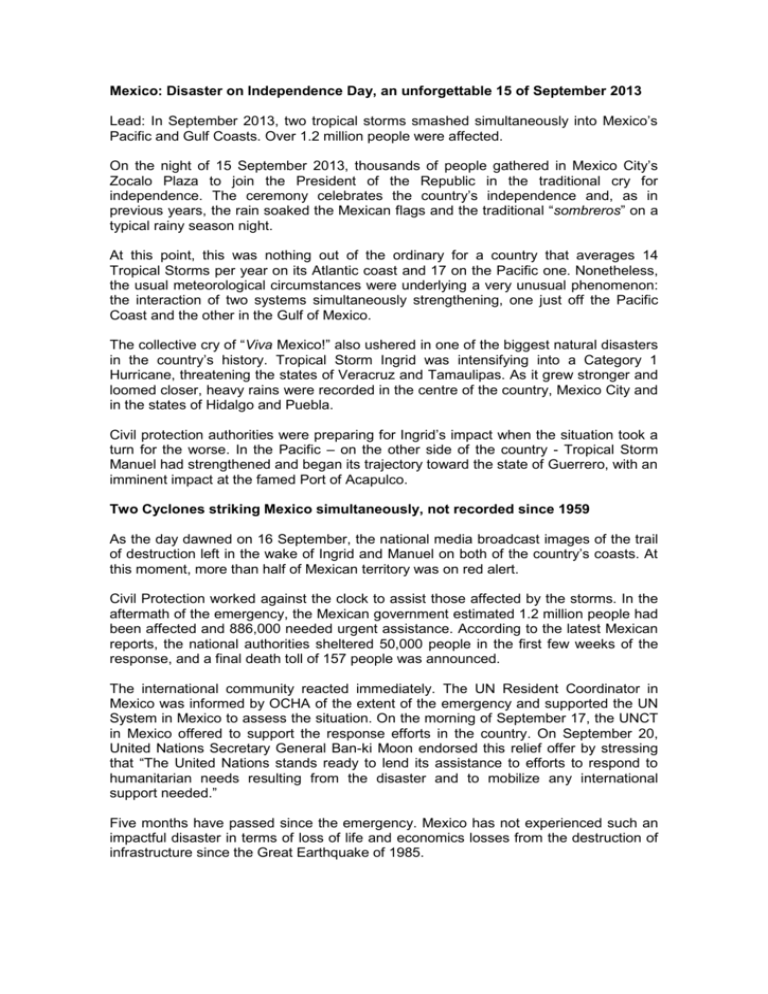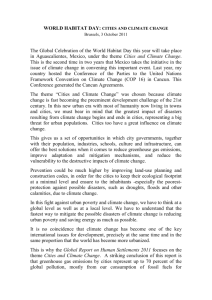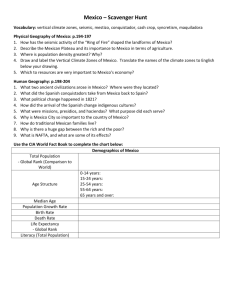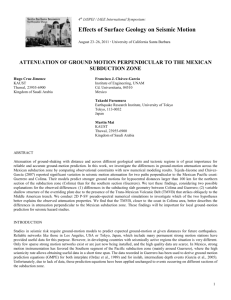Mexico_dual hurricanes_280114 ver1
advertisement

Mexico: Disaster on Independence Day, an unforgettable 15 of September 2013 Lead: In September 2013, two tropical storms smashed simultaneously into Mexico’s Pacific and Gulf Coasts. Over 1.2 million people were affected. On the night of 15 September 2013, thousands of people gathered in Mexico City’s Zocalo Plaza to join the President of the Republic in the traditional cry for independence. The ceremony celebrates the country’s independence and, as in previous years, the rain soaked the Mexican flags and the traditional “sombreros” on a typical rainy season night. At this point, this was nothing out of the ordinary for a country that averages 14 Tropical Storms per year on its Atlantic coast and 17 on the Pacific one. Nonetheless, the usual meteorological circumstances were underlying a very unusual phenomenon: the interaction of two systems simultaneously strengthening, one just off the Pacific Coast and the other in the Gulf of Mexico. The collective cry of “Viva Mexico!” also ushered in one of the biggest natural disasters in the country’s history. Tropical Storm Ingrid was intensifying into a Category 1 Hurricane, threatening the states of Veracruz and Tamaulipas. As it grew stronger and loomed closer, heavy rains were recorded in the centre of the country, Mexico City and in the states of Hidalgo and Puebla. Civil protection authorities were preparing for Ingrid’s impact when the situation took a turn for the worse. In the Pacific – on the other side of the country - Tropical Storm Manuel had strengthened and began its trajectory toward the state of Guerrero, with an imminent impact at the famed Port of Acapulco. Two Cyclones striking Mexico simultaneously, not recorded since 1959 As the day dawned on 16 September, the national media broadcast images of the trail of destruction left in the wake of Ingrid and Manuel on both of the country’s coasts. At this moment, more than half of Mexican territory was on red alert. Civil Protection worked against the clock to assist those affected by the storms. In the aftermath of the emergency, the Mexican government estimated 1.2 million people had been affected and 886,000 needed urgent assistance. According to the latest Mexican reports, the national authorities sheltered 50,000 people in the first few weeks of the response, and a final death toll of 157 people was announced. The international community reacted immediately. The UN Resident Coordinator in Mexico was informed by OCHA of the extent of the emergency and supported the UN System in Mexico to assess the situation. On the morning of September 17, the UNCT in Mexico offered to support the response efforts in the country. On September 20, United Nations Secretary General Ban-ki Moon endorsed this relief offer by stressing that “The United Nations stands ready to lend its assistance to efforts to respond to humanitarian needs resulting from the disaster and to mobilize any international support needed.” Five months have passed since the emergency. Mexico has not experienced such an impactful disaster in terms of loss of life and economics losses from the destruction of infrastructure since the Great Earthquake of 1985. The impact of this unusual meteorological phenomenon in Mexico leads us to wonder what would happen if a simultaneous impact of two different cyclones were to occur in Central America or the Caribbean. What would be the extent of the damage if two tropical storm simultaneously affected the most vulnerable zones in the region? Are these atypical phenomena related to climate change? Can we expect an increase of these “unusual” climatic interactions? One thing is certain, that preparedness and response have acquired more relevance in the region since vulnerable communities are more exposed to the threats of these powerful phenomena than ever before. One day free nations throughout the region will be able to celebrate their Independence Days without the suffering and destruction brought on by extreme climate change. In order to achieve this objective, we must continue to work together to create strong societies that are well-prepared and ready to act effectively in the face of extreme natural hazards. Only then will we be able to collectively celebrate our Resilience Day, even if it rains, snows, or quakes. Photos 1. After a number of bridges were destroyed by Hurricane Manuel, temporary ones were erected to allow for the transport of people and emergency supplies to some communities in the state of Guerrero. Juan Pablo O'Farrill/OCHA. 2. Homes damaged by Hurricane Manuel in Acapulco. Juan Pablo O'Farrill/OCHA. 3. OXFAM distributed farm animals to help those affected by Hurricane Manuel reestablish their livelihoods in the communities of Sierra de Guerrero. Juan Pablo O'Farrill/OCHA.







